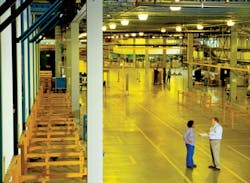Maintaining obsolete inventory consumes warehouse capacity and operating capital. It drains the cash flow of an inventory-based business. Those concerns are significant for any entity, but are particularly critical for companies that have broad product lines for which inventory turnover rates may vary immensely from one product to another.Generally accepted accounting principles (GAAP) require that inventory be stated in financial statements at cost or market value, whichever measure is lowest. If a company has not been regularly monitoring those values and adjusting accordingly, a sudden—and perhaps significant—charge to earnings might be required. Such an adjustment could shake confidence and trust among the company’s shareholders.For an inventory obsolescence review to be effective, individuals outside of the accounting department should be involved. Sales representatives, for example, interact with customers daily. They see market trends developing, they see customer preferences evolving. They hear signals of purchasing confidence or hesitancy among customers, signals that indicate potential fluctuations in product demand and general economic conditions. Purchasing managers, production supervisors and others likewise see changes in the daily inquiries, orders and requests they receive. Considering such disparate perspectives from individuals throughout the company yields valuable insights. With that broad input, an assessment of the market value of the inventory should be performed. Assigning market value may be difficult. Factors to consider include:• Recent and projected sales trends• General economic conditions• Product competition• Product lifecycle.Past sales reports—based on stock keeping unit (SKU) numbers, product line and other factors—offer greater detail, as do inventory movement reports and comparisons of an item’s quantity on hand to annual quantity sold. Inventory costs should be compared—by item—to current selling prices to determine if there is a reasonable profit margin. Inventory turnover ratios, disaggregated as appropriate—by product line, division, region or other classification—provide additional measures for determining acceptable inventory levels.Various quantifiable benchmarks, such as ideal item quantity levels, optimal turnover ratios and acceptable sales volumes, should then be set. If an inventory item fails to meet those standards, managers can analyze and address the underlying causes before the issue swells into a much larger concern.Continually comparing past projected requirements to actual needs helps managers improve and tweak inventory management processes. Involving an owner, president or chief operating officer in inventory reviews adds an entity-level control to those processes. Document proceduresIt’s wise to keep documentation of the company’s inventory obsolescence review procedures. Meeting minutes, reviewed and approved reports, and spreadsheets allay auditor concerns and provide valuable historical reference. Company policies and procedures relating to the inventory review should be documented, as well as appropriate approvals of those policies and procedures. Companies derive a variety of benefits from effectively monitoring inventory for obsolescence. By continually monitoring inventory for obsolescence, managers are much better equipped to respond to varying economic conditions, changing customer preferences, market competition and other challenges that arise. If inventory items are dropping in value, they can be sold at reduced prices before their value declines to nothing. Slow-moving items may also be donated to a charitable cause, yielding tax benefits and reduced storage costs. If items are not worthy of a charitable donation, inventory disposal also provides tax benefits.James R. Fitts, CPA, [email protected], is a partner in Assurance Services at Weaver and Tidwell LLP.
Subscribe to Automation World's RSS Feeds for Columns & Departments
About the Author
James R. Fitts
CPA
Sign up for our eNewsletters
Get the latest news and updates

Leaders relevant to this article:
